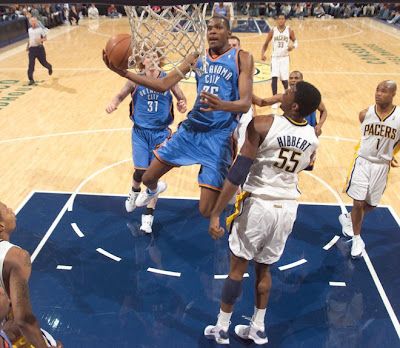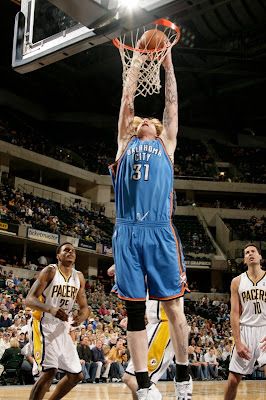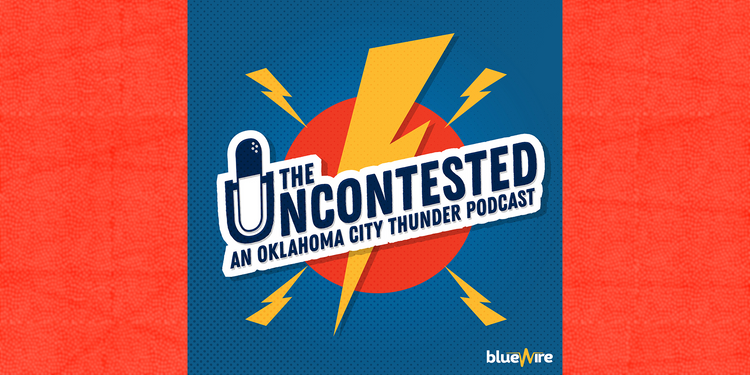Solving Oklahoma City’s shooting woes


The season is young, but there’s no hiding the fact that the Oklahoma City offense has struggled. Last night against the Pacers, the offense broke out a bit with 51 first half points (season high) and 97 points, but still shot only 38 percent from the field. The 97 points matches the highest total of the season and is only the second time in seven games the Thunder has topped 90.
Currently, the Thunder sits second to last in points per game (88.0) and dead last field goal percentage (40.4).
So what’s the deal? Why isn’t OKC scoring more and shooting better?
Brilliant, captain obvious answer: They aren’t good shooters.
The best teams know their strengths and weaknesses. A definite weakness for OKC is jump shooting. Other than Kevin Durant, there’s really no consistent jump shooter. Jeff Green has shot the ball from the outside a little better, but he’s not consistent. Earl Watson gets the gold star for shots that make you go, “That better effing go in. You just don’t take that only three seconds into the shot clock unless you make it. Which you didn’t.”
Compare OKC to the league’s best shooting team, the Phoenix Suns. Right now, the Suns are shooting over 51 percent from the field. First, it helps to have great shooters like they do. Steve Nash may be the purest shooter in the league, period. Second, it helps to have a dominant inside game with Amar’e Stoudemire and Shaquille O’Neal (especially when the bulk of those two’s shots are dunks). But most, it helps to be taking efficient shots.
(Disclaimer: Here comes a bunch of numbers.)
Through seven games, Oklahoma City is shooting an embarrassing 30.8 percent on jumpshots (118 for 383). That’s not good. For a comparison, the Suns are shooting 42 percent on jumpers and the league’s second best shooting team, the Utah Jazz, are at 48.5 percent. So that’s one aspect – OKC really just can’t hit a jumper with much regularity.
But what about the shots you’re supposed to make? The ones NBA players should be able to complete at a high rate? Well, the Suns are shooting over 72 percent on high percentage shots (layups and dunks), the Jazz 64.3 percent and the Thunder 59.9 percent. Not too bad, but not that great considering how poor OKC shoots the jay.
But here’s where it gets a little revealing – Oklahoma City is averaging 28.8 high percentage shots (HP) per game, while taking 54.7 jumpshots per game. It’s starting to make sense why they only shoot 40 percent. Phoenix takes just 22.8 high percentage shots a game (remember, making 72 percent of them), but also takes 47 jumpers per game. Utah takes 31.3 HP shots per game and 46.6 jumpers. So OKC is taking about seven or eight more low percentage shots a game than the two best shooting teams in the league. (A few more stats just because I spent the time calculating them: 32.2 percent of the Suns’ shots are HP, 40.1 percent for the Jazz and 34.5 percent for OKC.)
Phoenix converts such a high rate of their HP shots, meaning their high percent tries are typically better looks or they just plain have another dimension other than taking the jumper, whereas OKC does not. Both the Suns and the Jazz have post players that can cause defenses to sink into the lane a bit. Both have post players that can draw double-teams and open up wide-open kickouts. Right now, the Thunder has none of that. I don’t have the stat, but I would guess that guard Russell Westbrook has provided a substantial portion of the layup or dunk attempts.
Enter Robert Swift. As solid as he’s played in super limited minutes in two games, he gives us hope. Current starting center Johan Petro prefers to play outside of the lane and shoot 16 footers. Nick Collison shoots a lot of jumpers and gets most his points in the lane from put-backs. Swift is a true seven-foot post player with great hands and a solid inside game. If he can get healthy and get in solid game-shape, he could be

something that helps this offense. OKC can dump to the post, kick out and shoot. Or Swift could potentially score from there.
The Thunder’s offense has been simple thus far: Set an on-the-ball screen, roll off; if the shot isn’t there, repeat. Or pass to Kevin Durant and hope he nails an 18-footer over and outstretched defender. There’s not a lot of ball movement. There’s rarely more than four passes. There’s not much slashing and penetrating. There’s not much motion or rotation. All symptoms of a poor scoring team.
Also, the Suns average 71 shots per game. Oklahoma City averages 83. And that’s the fast, free-wheeling Suns we’re talking about. But the fact is, Phoenix is much more selective and takes higher percentage shots. The Hornets take 76 per game, Utah 78 and the Lakers 81. One guess as to why OKC is taking so many more shots is the fact that its played from behind in all but two games and has been trying to catch up, therefore hoisting shots earlier in the shot clock. The Thunder takes 44 percent of their shots 10 seconds or less into the shot clock. That sounds like there’s a lot of “settling for a jumper.” (Likewise, the Suns are taking 31 percent 10 seconds or less in and the Jazz 34 percent.)
I really have no idea what we learned here today other than obviously, teams shoot better when dunking or laying it in. So when you shoot just 30.8 percent when pulling up outside the lane, maybe that should tell you to take more high percentage shots. Don’t settle for a 22 foot jumper six seconds into the shot clock. Utilize the post and see if it opens up more open looks. The offense isn’t this bad, it’s just not running like it’s supposed to. Good thing there’s 75 more games to figure it out.

